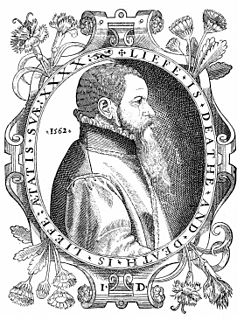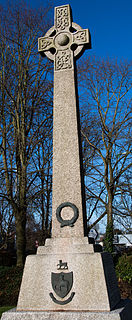
Hugh Latimer was a Fellow of Clare College, Cambridge, and Bishop of Worcester before the Reformation, and later Church of England chaplain to King Edward VI. In 1555 under the Catholic Queen Mary he was burned at the stake, becoming one of the three Oxford Martyrs of Anglicanism.

John Foxe, an English historian and martyrologist, was the author of Actes and Monuments, telling of Christian martyrs throughout Western history, but particularly the sufferings of English Protestants and proto-Protestants from the 14th century and in the reign of Mary I. Widely owned and read by English Puritans, the book helped to mould British opinion about the Catholic Church for several centuries.

John Day was an English Protestant printer. He specialised in printing and distributing Protestant literature and pamphlets, and produced many small-format religious books, such as ABCs, sermons, and translations of psalms. He found fame, however, as the publisher of John Foxe's Actes and Monuments, also known as the Book of Martyrs, the largest and most technologically accomplished book printed in sixteenth-century England.

Anne Askew was an English writer, poet, and Protestant martyr who was condemned as a heretic in England in the reign of Henry VIII of England. Apart from Margaret Cheyne, wife of Sir John Bulmer, who was similarly tortured and executed after the Pilgrimage of Grace in 1537, she is the only other woman on record known to have been both tortured in the Tower of London and burnt at the stake. She is also one of the earliest-known female poets to compose in the English language and the first Englishwoman to demand a divorce.
Ralph Baines or "Bayne" was the last Roman Catholic Bishop of Lichfield and Coventry, in England.

Agnes Prest was a Cornish Protestant martyr from the reign of the Catholic Queen Mary. She was burned at the stake at Southernhay in Exeter in 1557. According to Foxe's Book of Martyrs, and the story of Exeter Protestant Martyrs she lived near Launceston, Cornwall, and was married to a Catholic husband. She left her husband over his Catholicism, and went to be a spinner but she later on returned to him and was arrested and indicted at the Launceston Assizes. She was then put in Launceston jail and then transferred to Exeter jail. In Exeter jail, she was brought before the Bishop of Exeter, Bishop Turberville. When questioned, she denied the Catholic doctrine of transubstantiation. She was then released for a month. Whilst she was released, she is said to have met a Dutch stonemason in Exeter Cathedral who was repairing the statues of the saints beloved of the Catholics. According to Foxe, she said to him "What a madman art thou, to make them new noses, which within a few days shall all lose their heads". After that point she was returned to jail where she had many visitors, including Walter Raleigh's mother, Catherine Raleigh who praised her for her 'Godly life'. She was then tried for heresy by the Mayor of Exeter, refused to recant her beliefs and was executed by being burnt to death on 15 August 1557.

The Coventry Martyrs were a disparate group of Lollard Christians executed for their beliefs in Coventry between 1512 and 1522 and in 1555. Eleven of them are commemorated by a six-metre-high (20 ft) monument, erected in 1910 in a public garden in the city, between Little Park Street and Mile Lane; and by a mosaic constructed in 1953 inside the entrance to Broadgate House in the city centre. Some of the streets in the city’s Cheylesmore suburb are named after them.

Thomas Benet from Cambridge, was an English Protestant martyr during the reign of King Henry VIII. In 1524, he moved to Torrington, North Devon, with his wife and family so that he could exercise his religious conscience more freely in a county where no one knew him. He was executed by burning on 15 January 1531, for heresy, at Livery Dole outside Exeter in Devon, under the supervision of Sir Thomas Dennis (c.1477-1561) of Holcombe Burnell, near Exeter, then Sheriff of Devon.

The Colchester Martyrs were 16th-century English Protestant martyrs. They were executed for heresy in Colchester, Essex, during the reigns of Henry VIII and Mary I. Their story is recorded in Foxe's Book of Martyrs.
Margaret Polley was an English Protestant martyr from Popingberry, Rochester, Kent. Her story is recorded in Foxe's Book of Martyrs.
Christopher Wade was an English Protestant martyr. His story is recorded in Foxe's Book of Martyrs.
The Canterbury Martyrs were 16th-century English Protestant martyrs. They were executed for heresy in Canterbury, Kent, and were the last protestants burnt during the reign of Mary I. Their story is recorded in Foxe's Book of Martyrs.
Anthony Pearson was a 16th-century English Protestant who was executed for heresy during the reign of King Henry VIII of England. He is known as one of the Windsor Martyrs.
The Perth Martyrs were six people executed in Perth, Scotland in 1543 for their Protestant beliefs. The condemned people were William Anderson, James Finlayson, James Hunter, Robert Lamb, James Raveleson and Helen Stark. They were sentenced to death for their beliefs, after being convicted by the Archbishop of St Andrews. Anderson, Finlayson, Hunter and Lamb were sentenced to be hanged, Raveleson was to be burnt; and Helen Stark, "with her sucking infant", was to be put into a sack and drowned. Their story is recorded in Foxe's Book of Martyrs, in Calderwood's History of the Kirk of Scotland and in James Anthony Froude's History of England.
John Lawrence was a sixteenth-century English Protestant martyr. His story was recorded in Foxe's Book of Martyrs.

The Actes and Monuments, popularly known as Foxe's Book of Martyrs, is a work of Protestant history and martyrology by Protestant English historian John Foxe, first published in 1563 by John Day. It includes a polemical account of the sufferings of Protestants under the Catholic Church, with particular emphasis on England and Scotland. The book was highly influential in those countries and helped shape lasting popular notions of Catholicism there. The book went through four editions in Foxe's lifetime and a number of later editions and abridgements, including some that specifically reduced the text to a Book of Martyrs.

The Stratford Martyrs were eleven men and two women who were burned at the stake together for their Protestant beliefs, either at Stratford-le-Bow, Middlesex or Stratford, Essex, both near London, on 27 June 1556 during the Marian persecutions.
Sir Anthony Knyvett was an English courtier during the reign of King Henry VIII.









